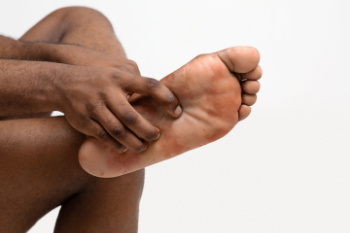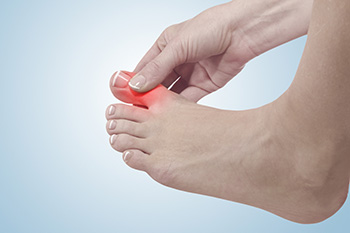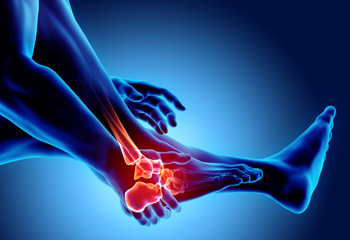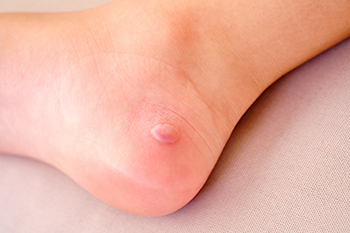Items filtered by date: January 2024
Facts About Plantar Fasciitis

Plantar fasciitis, the leading cause of heel pain, stems from inflammation or degeneration of the plantar fascia attaching to the heel. This thick tissue band, essential for foot support, manifests as pain under the heel, often extending into the arch. Symptoms of plantar fasciitis peak in the morning, but often subside as the foot warms throughout the day. Overuse is a key factor of plantar fasciitis, but risks heighten with poor foot biomechanics and other factors. These may include overpronation, a high-arched foot, and improper footwear choice. Additional contributors include excess weight, tight calf muscles, and plantar fascia tightness. Among the symptoms are morning heel pain, arch discomfort, and tenderness when pressing the heel. Distinguishing plantar fasciitis from similar conditions, such as a bruised heel, heel spur, or stress fracture aids in an accurate diagnosis. Treatment involves pain and inflammation reduction, biomechanical correction, and targeted exercises. For a tailored approach to managing plantar fasciitis, it is suggested that you consult a podiatrist for a full exam and suggested treatment. options.
Plantar fasciitis is a common foot condition that is often caused by a strain injury. If you are experiencing heel pain or symptoms of plantar fasciitis, contact Edward Sharrer, DPM from Premier Foot and Ankle Clinic. Our podiatrist can provide the care you need to keep you pain-free and on your feet.
What Is Plantar Fasciitis?
Plantar fasciitis is one of the most common causes of heel pain. The plantar fascia is a ligament that connects your heel to the front of your foot. When this ligament becomes inflamed, plantar fasciitis is the result. If you have plantar fasciitis you will have a stabbing pain that usually occurs with your first steps in the morning. As the day progresses and you walk around more, this pain will start to disappear, but it will return after long periods of standing or sitting.
What Causes Plantar Fasciitis?
- Excessive running
- Having high arches in your feet
- Other foot issues such as flat feet
- Pregnancy (due to the sudden weight gain)
- Being on your feet very often
There are some risk factors that may make you more likely to develop plantar fasciitis compared to others. The condition most commonly affects adults between the ages of 40 and 60. It also tends to affect people who are obese because the extra pounds result in extra stress being placed on the plantar fascia.
Prevention
- Take good care of your feet – Wear shoes that have good arch support and heel cushioning.
- Maintain a healthy weight
- If you are a runner, alternate running with other sports that won’t cause heel pain
There are a variety of treatment options available for plantar fasciitis along with the pain that accompanies it. Additionally, physical therapy is a very important component in the treatment process. It is important that you meet with your podiatrist to determine which treatment option is best for you.
If you have any questions, please feel free to contact our office located in North Little Rock, AZ . We offer the newest diagnostic and treatment technologies for all your foot care needs.
Arthritis Can Cause Pain in the Feet and Ankles
Suitable Shoes for Walking and Running

When it comes to choosing between running and walking shoes, understanding the key differences can make all the difference. Both walkers and runners have distinct footwear needs, and these needs are reflected in the design of their shoes. The important factors to consider include shoe weight, cushioning, and flexibility. Running shoes are typically lightweight, facilitating quick movements, while walking shoes are generally heavier to provide stability and support during a slower, consistent pace. Running shoes offer more cushioning in the forefoot and heel to absorb the impact of continuous running strides. Walkers require good foot support over extended periods. Running shoes are more flexible in the midfoot or arch, accommodating the runner's constant strike at their midfoot or the ball of their foot. Additionally, walkers need arch flexibility since they rely on their toes to push off. Regardless of your choice, monitor how your shoes support your needs during your walk, and remember to replace them after every 300 to 400 miles or every four to six months to maintain optimal comfort and prevent injury. If you need help in determining what the right shoes are for running or walking, it is suggested that you consult with a podiatrist who is an expert in feet and ankle knowledge.
For more information about walking shoes versus running shoes, consult with Edward Sharrer, DPM from Premier Foot and Ankle Clinic. Our podiatrist can measure your feet to determine what your needs are and help you find an appropriate pair of footwear.
Foot Health: The Differences between Walking & Running Shoes
There are great ways to stay in shape: running and walking are two great exercises to a healthy lifestyle. It is important to know that running shoes and walking shoes are not interchangeable. There is a key difference on how the feet hit the ground when someone is running or walking. This is why one should be aware that a shoe is designed differently for each activity.
You may be asking yourself what the real differences are between walking and running shoes and the answers may shock you.
Differences
Walking doesn’t involve as much stress or impact on the feet as running does. However, this doesn’t mean that you should be any less prepared. When you’re walking, you land on your heels and have your foot roll forward. This rolling motion requires additional support to the feet.
Flexibility – Walking shoes are designed to have soft, flexible soles. This allows the walker to push off easily with each step.
If you have any questions, please feel free to contact our office located in North Little Rock, AZ . We offer the newest diagnostic and treatment technologies for all your foot care needs.
Stages of Gout

Gout is a type of joint problem caused by the formation of tiny crystals. It happens when your body makes too much uric acid, or your kidneys do not get rid of it efficiently. This uric acid is a leftover from breaking down certain foods. When uric acid levels get too high, it turns into crystals that cannot dissolve and remain in your tissues, causing inflammation. Your body's defense cells try to absorb these crystals, but they may become damaged as a result of how sharp they are. Gout is more common in men and often shows up after age 30 or in women after menopause. Gout has four stages. The first stage involves high uric acid with no symptoms. The second stage includes painful joint attacks The third stage is generally pain-free periods between attacks. The fourth stage consists of severe gout with lumpy deposits that are known as tophi. During a gout attack, you will experience severe pain, redness, swelling, and warmth in the joint. The big toe is a common spot for gout, and over time, untreated gout can harm your joints. In severe cases, surgery may be needed if the joint damage is extensive. Gout can be diagnosed by examining joint fluid or having X-rays taken. If you believe you have gout, it is suggested that you schedule an appointment with a podiatrist for a proper diagnosis and treatment.
Gout is a foot condition that requires certain treatment and care. If you are seeking treatment, contact Edward Sharrer, DPM from Premier Foot and Ankle Clinic. Our podiatrist will treat your foot and ankle needs.
What Is Gout?
Gout is a type of arthritis caused by a buildup of uric acid in the bloodstream. It often develops in the foot, especially the big toe area, although it can manifest in other parts of the body as well. Gout can make walking and standing very painful and is especially common in diabetics and the obese.
People typically get gout because of a poor diet. Genetic predisposition is also a factor. The children of parents who have had gout frequently have a chance of developing it themselves.
Gout can easily be identified by redness and inflammation of the big toe and the surrounding areas of the foot. Other symptoms include extreme fatigue, joint pain, and running high fevers. Sometimes corticosteroid drugs can be prescribed to treat gout, but the best way to combat this disease is to get more exercise and eat a better diet.
If you have any questions please feel free to contact our office located in North Little Rock, AZ . We offer the newest diagnostic and treatment technologies for all your foot and ankle needs.
Risk Factors for Foot Stress Fractures

Understanding the risk factors associated with foot stress fractures is pivotal in preemptively addressing this common injury. Repetitive stress on the foot, often incurred through high-impact activities like running or jumping, emerges as a primary catalyst. Insufficient conditioning or abrupt increases in activity levels can amplify the risk, as the bones may not be adequately prepared for the intensified load. Foot anatomy also plays a role, with individuals having high arches or flat feet being more susceptible. Wearing inadequate footwear, and lacking proper support or shock absorption, further heightens the risk. Nutritional deficiencies, especially in calcium and vitamin D, compromise bone strength, rendering them more prone to fractures. Additionally, hormonal imbalances, prevalent in conditions like female athlete triad or among those with irregular menstrual cycles, contribute to bone weakening. If you have incurred a foot stress fracture, it is suggested that you speak to a podiatrist who can treat it accordingly, and offer effective prevention techniques.
Stress fractures occur when there is a tiny crack within a bone. To learn more, contact Edward Sharrer, DPM from Premier Foot and Ankle Clinic. Our podiatrist can provide the care you need to keep you pain free and on your feet.
How Are They Caused?
Stress fractures are the result of repetitive force being placed on the bone. Since the lower leg and feet often carry most of the body’s weight, stress fractures are likely to occur in these areas. If you rush into a new exercise, you are more likely to develop a stress fracture since you are starting too much, too soon. Pain resulting from stress fractures may go unnoticed at first, however it may start to worsen over time.
Risk Factors
- Gender – They are more commonly found in women compared to men.
- Foot Problems – People with unusual arches in their feet are more likely to develop stress fractures.
- Certain Sports – Dancers, gymnasts, tennis players, runners, and basketball players are more likely to develop stress fractures.
- Lack of Nutrients – A lack of vitamin D and calcium may weaken the bones and make you more prone to stress fractures
- Weak Bones – Osteoporosis can weaken the bones therefore resulting in stress fractures
Stress fractures do not always heal properly, so it is important that you seek help from a podiatrist if you suspect you may have one. Ignoring your stress fracture may cause it to worsen, and you may develop chronic pain as well as additional fractures.
If you have any questions, please feel free to contact our office located in North Little Rock, AZ . We offer the newest diagnostic and treatment technologies for all your foot care needs.
Understanding a Diabetic Foot Blister

A diabetic foot blister, a manifestation of the complexities associated with diabetes, emerges as a consequence of heightened vulnerability to skin injuries. Diabetes, a metabolic condition affecting blood sugar regulation, often leads to impaired circulation and compromised nerve function in the extremities. This diminished sensation, known as diabetic neuropathy, means that individuals with diabetes may not readily detect friction or pressure that can result in blisters. When blisters form, the impaired circulation slows the healing process, making these normally benign lesions potential precursors to more severe complications. The risk of infection in a diabetic foot blister is elevated, posing a serious threat to foot health. Regular foot inspections, meticulous hygiene practices, and appropriate footwear choices become paramount for individuals navigating the delicate balance of diabetes. If you have developed this type of blister, it is strongly suggested that you are under the care of a podiatrist who can guide you toward correct treatment methods.
Blisters are prone to making everyday activities extremely uncomfortable. If your feet are hurting, contact Edward Sharrer, DPM of Premier Foot and Ankle Clinic. Our podiatrist can provide the care you need to keep you pain-free and on your feet.
Foot Blisters
Foot blisters develop as a result of constantly wearing tight or ill-fitting footwear. This happens due to the constant rubbing from the shoe, which can often lead to pain.
What Are Foot Blisters?
A foot blister is a small fluid-filled pocket that forms on the upper-most layer of the skin. Blisters are filled with clear fluid and can lead to blood drainage or pus if the area becomes infected.
How Do Blisters Form?
Blisters on the feet are often the result of constant friction of skin and material, usually by shoe rubbing. Walking in sandals, boots, or shoes that don’t fit properly for long periods of time can result in a blister. Having consistent foot moisture and humidity can easily lead to blister formation.
Prevention & Treatment
It is important to properly care for the affected area in order to prevent infection and ease the pain. Do not lance the blister and use a Band-Aid to provide pain relief. Also, be sure to keep your feet dry and wear proper fitting shoes. If you see blood or pus in a blister, seek assistance from a podiatrist.
If you have any questions, please feel free to contact our office located in North Little Rock, AZ . We offer the newest diagnostic and treatment technologies for all your foot care needs.

